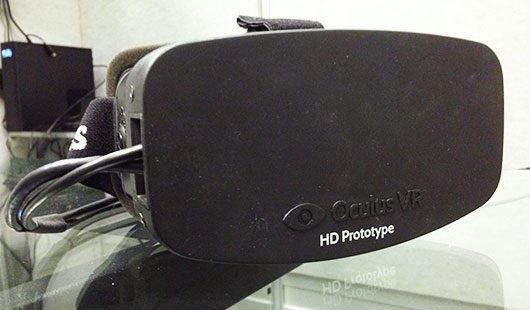An article covering Oculus’ appearance at GDC Europe 2013 claims that the company will release an Oculus Rift HD dev kit prior to the release of the consumer version in 2014.
Update 2 (10/19/2013): Oculus has doubled back on what they told us at Gamescom and have now officially confirmed that an Oculus Rift dev kit 2 (DK2) would ship before the consumer model.
Update: At Gamescom 2013, Road to VR’s Paul James spoke with Oculus VR Inc Founder, Palmer Luckey and VP of Product Nate Mitchell, who confirmed that there would be no Oculus Rift HD dev kit before the consumer version ships sometime in 2014.
Original article:
Oculus VR Inc first showed the Oculus Rift HD prototype at E3 2013 in June. As the original Oculus Rift dev kit (DK1) was still shipping out in high demand, it was an unexpected but welcome development. It wowed much of the gaming press at E3 and came away with a slew of awards, including the Game Critic Awards ‘Best Hardware’ at E3.
But Oculus was careful to call this a prototype, rather than a forthcoming dev kit, saying that they had “no solid plans” to release it, and only had it at the show to demonstrate the progress they were making.
Covering the Oculus Rift at last weekend’s GDC Europe 2013, Heise.de claims that the company plans to release an Oculus Rift HD dev kit (DK2) before the consumer version of the Oculus Rift ships. The article was written in German and kindly translated by Reddit user ‘jacenat’:
Eine verbesserte Entwicklerversion der Rift, die ursprünglich für die zweite Jahreshälfte vorgesehen war, hat man jedoch auf “kurz vor” der Veröffentlichung der endgültigen Verkaufsversion verschoben, da sie möglichst die gleichen Spezifikationen einhalten soll. Bis dahin müssen Entwickler mit der aktuellen 720p-Auflösung auskommen
An improved developer version of the Rift, previously scheduled for the 2nd half of the year, was pushed back to “shortly before” the release of the consumer version to make it as equal as possible to the consumer version. Until then developers have to rely on the current kit with its 720p resolution.
The article doesn’t mention precisely where this info came from, but does have other quotes from some of the Oculus executives.
The ‘previously scheduled’ bit mentioned refers presumably to an old roadmap that Oculus showed in March at GTC 2013. That roadmap indicated that the company anticipated launching a DK2 in Q3 2013. More recently, Oculus has indicated that we wouldn’t see the consumer version ‘Oculus Rift 2’ in 2013. If the article from Heise is accurate and the Oculus Rift HD dev kit (DK2) is to launch “shortly before” the consumer version, than it would likely be in 2014 as well.
So far there’s no official announcement from Oculus VR Inc about an HD dev kit (DK2) or a release date of the consumer version of the Oculus Rift.
At previous recent tradeshows, the company appeared to have only one Oculus Rift HD prototype.

At Gamescom 2013, held this week in Germany, the Oculus VR Inc booth has a larger fleet of Oculus Rift HD prototypes, perhaps indicating that they’re indeed moving forward on that trajectory.
Road to VR’s Paul James is on the ground at Gamescome 2013, we’ll see if he can’t get to the bottom of this!







